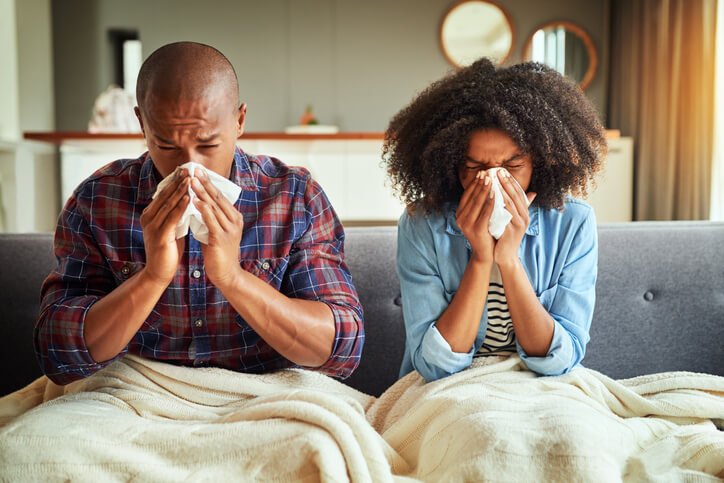1. Andrographis: To Reduce Duration
Andrographis (
Andrographis paniculata) is an herbaceous plant native to India and Sri Lanka. It is a primary herb for the treatment of fever and infectious illnesses in both traditional Chinese medicine and Ayurvedic medicine.
The antimicrobial and immune-enhancing properties of andrographis have garnered significant scientific attention, and research has shown that this botanical is a powerful ally in the treatment of colds and flu. When taken within the first 36 to 48 hours of illness, andrographis can significantly reduce the severity and duration of upper respiratory infections. (
8) Andrographolide, a primary compound derived from andrographis, may also inhibit influenza virus replication and reduce virus-induced inflammation, the cause of multiple flu symptoms such as fatigue and muscle soreness. (
9,
10) In fact, these beneficial properties have made andrographis a popular remedy in Europe for the treatment of influenza. (
11)
Because the available research on andrographis is variable in terms of extracts and dosages used, it is difficult to determine the optimal dosage for treating colds and flu. (
12) However, the lower end of the dosage range used in clinical trials is 400 mg of andrographis (standardized for andrographolide content) three times per day, and the upper end is 1,000 to 2,000 mg three times per day. Andrographis at these dosages is intended for short-term use.
2. Honey: For Coughs and to Speed Recovery
Honey promotes recovery from viral respiratory infections. Manuka honey, a type of honey produced by bees that feed on the nectar of the New Zealand tea tree, inhibits flu virus replication. (It also boosts the effectiveness of certain antiviral drugs used for the treatment of influenza—the prescription drug Tamiflu is one example.) (
13,
14) Honey has also been shown to be
more effective than dextromethorphan and diphenhydramine, the most common active ingredients in OTC cough medicines, at improving nightly cough and sleep quality in children with upper respiratory infections. (
15)
Methylglyoxal (MGO) is the primary anti-influenza ingredient in Manuka honey. When selecting Manuka honey for medicinal uses, look for the “MGO” label on the jar—it should state a minimum MGO content of 83. The higher the MGO rating, the higher the level of antiviral activity of the honey.
3. Propolis: To Speed Recovery
Propolis is a resinous mixture produced when bees mix their saliva and beeswax with secretions gathered from tree buds and other botanical sources.
Bees use propolis to protect their community from bacterial, fungal, and viral pathogens, essentially making propolis the “immune system” of the hive. It turns out that the “immune system” of the beehive also benefits the human immune system. Propolis contains polyphenolic compounds with anti-influenza activity and, when administered nasally, may significantly accelerate recovery from the common cold. (
16,
17)
To accelerate recovery from colds and flu, begin with one tablespoon of high-MGO Manuka honey per day. Complement this with a propolis throat spray, such as
this one by Beekeeper’s Naturals.
4. Bovine Colostrum: For Prevention
Bovine colostrum is the first milk produced a cow following the birth of a calf. It has a similar structure to human colostrum and proffers comparable immune-boosting benefits. In fact, bovine colostrum has been found to be effective at preventing the flu and it significantly reduces the number of episodes and hospitalizations for respiratory infections in children. (
18,
19) You can purchase bovine colostrum as a powder or capsule; just choose a supplement from
grass-fed, hormone-free, and antibiotic-free cows to ensure that you are getting the healthiest product possible.
5. Chinese Skullcap: For Prevention and Treatment
Chinese skullcap (
Scutellaria baicalensis) is an
antiviral that’s often effective against drug-resistant and nonresistant strains of influenza and cold-causing viruses. (
20,
21) It’s been shown to stop viruses from reproducing, inhibit proteins present on influenza viruses that facilitate their adhesion to cells, suppress viral gene expression, protect cell membranes from virus-associated inflammation, and boost immunity.
The root extract of Chinese skullcap can be taken for colds and flu in tincture form at a dose of one-fourth to one-half teaspoon three times daily or as one teaspoon of powdered root three to six times a day.
Chinese skullcap should not be taken during pregnancy and should be used with caution if you are taking any medications because it can increase the bioavailability of the drugs, intensifying their effects on the body.
6. Echinacea: For Prevention and Treatment
Echinacea refers to a group of herbaceous flowering plants in the daisy family native to Eastern and Central North America.
Historically, Native Americans used echinacea to treat severe infections; today, the anti-infective properties of echinacea have been demonstrated by several clinical trials.
In one trial, 755 subjects were given either
Echinacea purpurea or placebo for four months; those in the echinacea group experienced a significantly reduced occurrence of virally confirmed cold episodes. (
22) A second clinical trial found echinacea to be as effective as the antiviral drug oseltamivir (Tamiflu) for the early treatment of influenza virus infections. However, unlike oseltamivir, echinacea does not run the risk of inducing antiviral drug resistance. (
23)
Echinacea can be consumed as a tea or tincture or in capsules. If you take echinacea in a liquid form (tea or tincture), retain the dose in your mouth for approximately 10 seconds before swallowing to boost the local antiviral effects on oral tissues. (
24)
7. Elderberry: To Shorten Duration and Treat Symptoms
The small, dark purple berries of the elderberry plant have a long history of use for the treatment of colds and flu.
Elderberry extracts alleviate cold and flu symptoms and can significantly shorten the duration of illness by two to four days. (
25,
26) Elderberry may battle cold and flu viruses by increasing serum antioxidant capacity.
Elderberry syrup is a time-honored and palatable method for consuming elderberry and can be taken in a dosage of 15 mL four times a day until cold and flu symptoms abate. Elderberry lozenges are another option that also frequently contain other immune-supportive ingredients, such as zinc. Elderberry is safe to consume during pregnancy and has no known drug interactions.
8. Garlic: For Prevention and to Reduce Severity
The humble garlic bulb has quite a colorful history—in medieval times, garlic was worn on the body to ward off the “evil eye” and hung in homes to protect against supernatural entities believed to cause illness. Today, it has become clear that these superstitions held a grain of truth; while garlic may not ward off the evil eye or malicious spirits (or vampires),
it does help to protect against disease-causing agents, including viruses.
Allicin, a compound released when a garlic clove is crushed, smashed, or chopped, has been shown to boost immunity against cold-causing viruses. (
27) Aged garlic extract, a preparation that lacks the pungent scent of fresh garlic, may reduce cold and flu severity by enhancing the function of immune cells and reducing virus-induced inflammation. (
28,
29)
The dose of aged garlic extract used in clinical trials for colds and flu is approximately 2.5 g per day. The optimal dosages of fresh and dried garlic for colds and flu have not been determined, but clinical trials examining the broad-spectrum antimicrobial properties of garlic have used dosages between 600 and 1,200 mg per day.
9. Ginger: For Prevention and Treatment
In China and Japan, ginger is a key supportive ingredient in traditional herbal formulas for treating the common cold. Scientific research indicates that fresh ginger may have antiviral activity against certain viruses that infect the respiratory system. (
30)
To get the maximum antiviral benefits of ginger, I recommend making the following
ginger tea recipe:
- Juice 1 to 2 pounds of ginger; place juice in a jar and refrigerate.
- Place 2 to 4 ounces of ginger juice in a mug with the juice of one-half lemon and a large tablespoon of honey. I recommend Beekeeper’s Naturals honey. Add one-eighth teaspoon of cayenne pepper and 6 ounces of hot water.
- Drink 2 to 6 cups of this a day, sipping slowly throughout the day.
10. Houttuynia: For Prevention and Treatment
Houttuynia cordata is a traditional Chinese herb active against multiple respiratory viruses, including influenza. It can be taken in a tincture or as a powdered dry herb. For viral respiratory infections, the recommended dose of tincture is one-fourth to one-half teaspoon six times per day or one-half teaspoon three to six times daily for the dried herb.
11. Licorice: For Prevention and Treatment
Licorice root (
Glycyrrhiza glabra) is a botanical medicine with broad-spectrum antiviral properties.
Glycyrrhizin, the sweet-tasting constituent of licorice root, can inhibit the replication of influenza virus while also reducing virus-associated inflammation. (
31)
Licorice can be taken in tincture form at a dosage of 30 to 60 drops up to three times a day or in capsules at a dosage of 4 g per day in two to three divided doses.
Licorice should not be taken in large doses or for long periods during pregnancy because it may have harmful effects on the unborn child. The phytochemicals in licorice root also have blood pressure-raising and mild estrogenic effects, so it should not be taken for more than 10 days by people with hypertension, hypokalemia, hypernatremia, or low testosterone levels.
12. Lomatium: For Treatment
Lomatium is a member of the carrot family native to western North America. While studies on the antiviral activity of Lomatium are scarce, the herb has a long history of use by Native American peoples for the treatment of infections.
Anecdotally, herbalists have found lomatium useful for treating several types of influenza.
Lomatium should not be taken during pregnancy. Some people may experience a rash, which seems to be harmless, upon ingestion of lomatium. According to herbalist Stephen Harrod Buhner, the rash is typically dark red or purplish in color, covers the whole body, causes little to no itching or discomfort, and disappears in about a week’s time. Using lomatium as part of a mixture of herbs, rather than on its own, may prevent the rash.
13. Medicinal Mushrooms: For Prevention
Medicinal mushrooms are all the rage right now, and for a good reason:
they have a broad spectrum of health benefits, including helping the immune system respond to viruses. Glucan, a polysaccharide found in medicinal mushrooms, enhances the immune response against the influenza virus. (
32) Glucans are found in chaga, Cordyceps, reishi, and shiitake mushrooms.
Medicinal mushroom extracts are available in many different forms, including tinctures, capsules, and teas.
14. Probiotics: For Prevention
According to recent research, a healthy gut microbiota is crucial for initiating an appropriate immune response to the influenza virus. (
33)
Fermented foods and
probiotics that introduce beneficial bacteria to the gut are potent tools for preventing and fighting cold and flu viruses. A recent study found that when adults who suffered from frequent colds were supplemented with
Lactobacillus paracasei,
Lactobacillus casei, and
Lactobacillus fermentum for 12 weeks, they experienced a significant reduction in the number of upper respiratory infections. (
34) Eating lacto-fermented yogurt has also been found to reduce the risk of catching a common cold in healthy elderly individuals. (
35)
In an animal study, mice were given
Lactobacillus casei isolated from kimchi, a staple fermented vegetable dish in Korean cuisine. The mice treated with
L. casei experienced reduced weight loss after virus infection and lower levels of viral replication in their lungs. (
36)
Unfortunately, catching the flu does have some harmful effects on the gut; flu-infected patients experience reductions in intestinal microbiota diversity and increases in opportunistic
E. coli and
Enterococcus faecium. Taking
Lactobacillus probiotics and eating lacto-fermented foods may help prevent or reduce these adverse effects.
15. Olive Leaf: For Prevention
Olive leaf contains three
polyphenols—a type of micronutrient found in plant-based foods—with potent antiviral properties. Olive leaf extract changes the membrane of the influenza virus, preventing it from attaching to and penetrating cells. (
37,
38)
Olive leaf can be taken in the form of a tincture, capsules, or tea. The typical dosage range is 500 to 1,000 mg per day.
16. Red Root: For Treatment
Red root (
Ceanothus americanus) is native to the Americas. While there hasn’t been much scientific study on red root,
the deep red tincture and tea extracted from its roots have long been used for treating respiratory infections.
In his excellent book
Herbal Antivirals: Natural Remedies for Emerging and Resistant Viral Infections, herbalist Stephen Harrod Buhner provides a recipe for an herbal immune tonic that includes red root and several of the other antiviral botanicals I’ve mentioned above.
Here’s the formula for the immune-tonic combo:
- Mix two parts lomatium, two parts red root, two parts licorice, and one part isatis (all in tincture form).
- Take 30 to 60 drops mixed with 1 to 2 ounces of water each hour until condition improves. You may have trouble finding some of these botanicals locally, but you can get them fairly easily online.
17. Selenium: For Prevention
Selenium helps to balance and regulate the immune system and is crucial in optimizing your defenses against cold and flu viruses.
Selenium deficiency has been found to cause the flu virus to mutate into more virulent forms, but replenishment of this trace mineral can improve the immune response to viral respiratory infections. (
39,
40)
During cold and flu season, feel free to take 200 mcg of selenium three to four days a week. However, beyond the flu season,
I don’t recommend supplementing with selenium long term because continuous selenium supplementation has been associated with an increased risk of prostate cancer in men. Instead of supplementing outside of cold and flu season, optimize your intake of selenium-rich foods such as:
- Brazil nuts
- Cremini mushrooms
- Shiitake mushrooms
- Cod
- Shrimp
- Tuna
- Halibut
- Scallops
- Chicken
- Eggs
- Lamb
- Turkey
18. Vitamins A and D: For Prevention
Vitamins A and D work synergistically to support your immune health.
In fact, host resistance and susceptibility to influenza infection appear to depend importantly on the ratio of vitamin D to vitamin A activity in the body. (
41)
Extra-virgin cod liver oil is an excellent source of vitamins A and D in the proper ratio for promoting optimal immune function.
19. Vitamin C: To Reduce Duration
Over the years, there has been much debate over whether vitamin C is useful for treating colds and the flu. A recent meta-analysis of studies concluded that extra doses of vitamin C taken at the onset of a cold significantly reduce its duration. (
42)
During cold and flu season, consider taking 1,000 to 4,000 mg of supplemental vitamin C per day. I recommend a liposomal vitamin C because it is rapidly absorbed and highly bioavailable.
20. Zinc: To Reduce Duration
Zinc is another immune-boosting nutrient that many people don’t get enough of in their diets. According to a review of trials that assessed the body of literature on zinc for the common cold, zinc administered within the first 24 hours of a cold can significantly reduce the duration and severity of symptoms. (
43)
I recommend taking 30 mg per day of zinc picolinate or zinc gluconate at the first sign of a cold to speed up your recovery.
For the Best Effect, Live a Healthy Lifestyle, Too
While the natural remedies I’ve mentioned above are excellent cold and flu fighters,
they should be combined with healthy, ancestral lifestyle choices to achieve the greatest impact.
Getting high-quality sleep, reducing your stress, and eating a nutrient-dense, whole-foods diet will do wonders to support your recovery from a cold or the flu.
Get Plenty of Sleep
Getting
plenty of sleep is essential for recovering from colds and flu, as well as preventing their onset. Insufficient sleep and poor sleep quality are associated with reduced resistance to the common cold; this effect undoubtedly holds true for the flu as well, since sleep deprivation compromises immunity. (
44)
In addition to getting plenty of sleep—around eight hours per night is a good goal—you should also work on
optimizing your circadian rhythm. Circadian rhythm disruption, caused by factors such as
blue light exposure before bed and abnormal sleep patterns, primes the body for viral infection. (
45)
Reduce Stress
Mental and emotional stress depresses the immune system, making it harder to fight off colds and flu.
Stress reduction practices should be a crucial part of your recovery process; in fact,
meditation has been found to reduce the severity of cold and flu illness. (
46) If you want to reduce your stress but don’t know where to begin, try a meditation app such as
Headspace,
Calm, or
Waking Up, or practice some easy
breathing exercises.
Allow Yourself to Rest
In our 24/7 on-the-go society,
busyness is often valued over rest. However, if you want to give your body the opportunity to heal from a cold or flu, then rest is essential. Give yourself permission to curl up with a good book and some hot tea (such as the immune-boosting ginger tea I mentioned above) or take a nap. Getting some much-needed rest will actually
make you more productive by reducing the duration of your illness.
Eat a Nutrient-Dense, Whole-Foods Diet
Eating a
nutrient-dense, whole-foods diet is also crucial when recovering from a cold or the flu. Avoid
sugar, refined grains, and industrial seed oils, which impair immune function, and instead focus on eating high-quality animal proteins, non-starchy vegetables, moderate amounts of starchy plants such as sweet potatoes, some vitamin C-rich fruit, and
healthy fats.

 The tea seems to be a safer option. They're quite potent too, based on Laura's recipe I added too much dried fruit to my tea. Maybe that's why it didn't tase too nice. Kind of like berry tea mixed with raw potato juice.
The tea seems to be a safer option. They're quite potent too, based on Laura's recipe I added too much dried fruit to my tea. Maybe that's why it didn't tase too nice. Kind of like berry tea mixed with raw potato juice.
 I'm OK, I resumed drinking elderberry but I prefer to stick to tea only. So far so good, no negative symptoms whatsoever
I'm OK, I resumed drinking elderberry but I prefer to stick to tea only. So far so good, no negative symptoms whatsoever 




